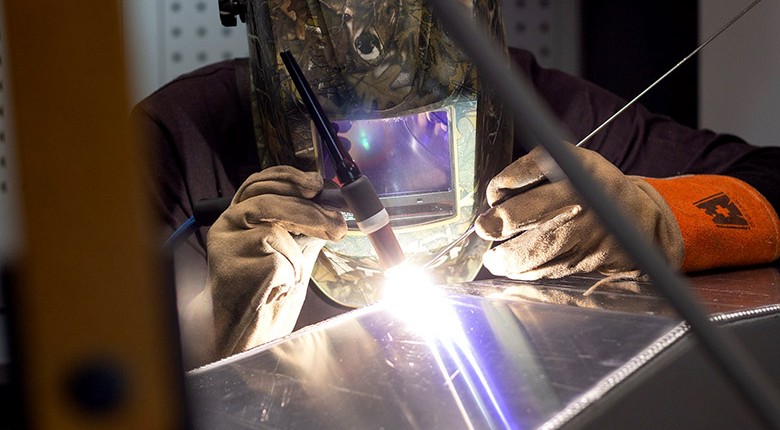Whatever motorsport you’re interested in, welding plays a vital role in the construction and modification of your vehicle. If you want to lay down precise, tidy, and strong welds on anything from steel and aluminium to the fussiest titanium, TIG welding is king.
TIG is a welding method that uses a tungsten electrode to transfer the arc from the welder to the material we’re working on. That arc is shielded by inert gas to protect the weld from contaminants in the atmosphere.
A TIG welder relies on hand-feeding the filler material into the weld pool created by the arc, which gives the user the ability to control when and how much filler rod is introduced into the weld. This allows for much more precision.
In this article, we’re going to dive into what TIG welding is, how it works, why it’s so good, and how you can learn to TIG weld for yourself.
What Does TIG Mean?
TIG stands for Tungsten Inert Gas. The "tungsten" part of the name refers to the electrode used to transfer the arc from the welder to the material we’re working on.
"Inert gas" refers to the shielding gas that protects the weld area from contamination. This gas is usually argon or a mixture of argon and helium, and prevents oxidation and other reactions that can occur when metals are exposed to air at high temperatures.
What is TIG Welding Used For?
The truth is, there are plenty of jobs in motorsport that we use a TIG welder for that could be done with a MIG welder, however the results would likely be sub-par at best. TIG is the preferred choice of any serious fabricator thanks to its highly precise nature — especially on thinner materials.
Although it’s more challenging to master and more time-consuming to use, TIG is ideal for nearly any job on a vehicle that requires intricacy, strength, and good looks.
Although it can be used with nearly all material types, you’ll most often find TIG welding carried out on chromoly, stainless steel, aluminium, and titanium — this is due to these materials being much less forgiving in terms of heat than something like mild steel, again requiring more control over the heat input.
TIG welding can be used to carry out most fabrication jobs on a vehicle, but it’s most commonly used in the construction of:
- Exhaust manifolds
- Intake piping and plenums
- Suspension and steering components
- Breather tanks, catch cans, and reservoirs
- Intercooler plumbing
- Chromoly roll cages
How Does TIG Welding Work?
TIG welding uses a tungsten electrode mounted in a hand-held torch to create the weld. This tungsten electrode generates an electrical arc when current flows through it, creating the intense heat necessary to melt the metal at the welding joint.
The tungsten's high melting point allows it to maintain its form and functionality despite the extreme temperatures it sees. There are many settings on a TIG machine that allow the user to precisely control how the arc behaves.
While the tungsten is producing its arc, gas — typically argon or a mixture of argon and helium — is directed over the weld area through the welding torch. This “shielding gas” protects the weld pool from oxidation and other reactions that could weaken it, and how it’s distributed can be manipulated by adjusting its flow rate from the tank, or by swapping to different gas cups and lenses.
A filler material in the form of a rod of whatever material it is you’re working with is then added to the molten weld pool by hand to create the weld. With that said, if the fit-up between the two parts is good enough, it is entirely possible to create a strong weld without filler material, simply by melting the pieces together.
What are the Benefits of TIG Welding?
The key benefits of TIG welding are:
- Finer control
- Superior weld strength and uniformity
- Better heat management
- Nicer looking welds
- No spatter
- Ability to work with smaller, more intricate welds
Because nearly every aspect of the welding operation can be controlled, from the machine’s settings and the gas coverage, to the speed at which the operator feeds in the filler material — TIG welding offers the ultimate control.
This control is especially important when it comes to materials like aluminium, stainless, and titanium that are sensitive to heat input. Using TIG you’re able to precisely manipulate how much heat is being introduced into the material, avoiding problems with parts distorting, warping and cracking, burning right through the weld, oxidation, and even material weakening.
Heat aside, TIG’s level of control simply produces a higher quality weld that’s cleaner, tidier, stronger, and more compact than anything a MIG could produce, providing that signature “stacked dimes” look that everyone loves. This also allows for more intricate welding on smaller components or in tighter spaces.
A final benefit that’s often overlooked is the fact that this method of welding produces almost no “spatter”, meaning you won’t have to spend hours cleaning up your welds after they’ve been laid down or perform that special dance only a hot ball of molten metal landing in your shoe or going down your shirt can inspire.
What is the Difference Between MIG and TIG Welding?
The primary difference between MIG and TIG welding lies in their welding processes.
While they both use an inert or semi-inert gas to shield the weld, unlike TIG’s tungsten electrode and hand-fed filler material, MIG welding utilises a consumable wire electrode that continuously feeds through the welding gun, melting to form the weld.
Although this article is clearly TIG-focused and it’s certainly what we prefer using in our workshop, MIG does have some advantages — it’s easier to learn and much faster to perform, making it good for big jobs, especially if thicker materials are involved.
For everything else, though, TIG is the answer, as although it requires more patience, skill, and experience, its benefits make it more than worth the extra time and effort you’ll need to put into it in order to get a good result.
Ultimately, you can think of MIG welding as a cleaver, and TIG welding as a scalpel — both might be able to do the same job, but we all know which tool we’d rather our surgeon use in the operating room.
How Can I Learn to TIG Weld?
Many enthusiasts are OK with getting behind a MIG torch and throwing some weld down but rely on the services of a specialised fabricator when it comes to TIG welding in the belief that it’s beyond their skill level. This gets expensive, fast!
The reality is that everyone is capable of TIG welding at a professional level. This high level of work is achievable for the average enthusiast in their own workshop or garage, provided you have a little patience and you’re prepared to put some time into learning and perfecting the crucial skills needed.
High Performance Academy’s Practical TIG Welding course is the perfect place to learn these skills, all from the comfort of your own home. This course covers everything you need to know to become a proficient TIG welder, and takes everything you’ve learnt and puts it into a simple six-step process that can be followed to take any project from initial design to finished product.
Enrol in the Practical TIG Welding course if you’d like to learn more.






